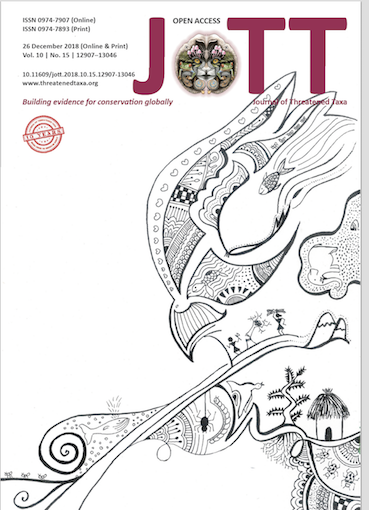The identification of Takin Budorcas taxicolor (Mammalia: Bovidae) through dorsal guard hair
Main Article Content
Abstract
The dorsal guard hairs of Takin Budorcas taxicolor was examined using the optical light and scanning electron microscopes for species identification. It is found that the dorsal guard hair of B. taxicolor is possessed a completely unique microscopic characteristic especially the medullary character-uniserial ladder structure, which differs from other species of mammals. The ‘irregular wave’ of scale patterns and ‘rippled’ scale margins of cuticular, and the ‘circular’ shape of a transverse section of hair also determines the species identity of B. taxicolor, because these characteristics are infrequent in other species of mammals. The micro-photographs and characters of hairs are presented here can be used in the forensic science, as an appropriate reference for species identification of B. taxicolor.
Article Details
Authors own the copyright to the articles published in JoTT. This is indicated explicitly in each publication. The authors grant permission to the publisher Wildlife Information Liaison Development (WILD) Society to publish the article in the Journal of Threatened Taxa. The authors recognize WILD as the original publisher, and to sell hard copies of the Journal and article to any buyer. JoTT is registered under the Creative Commons Attribution 4.0 International License (CC BY), which allows authors to retain copyright ownership. Under this license the authors allow anyone to download, cite, use the data, modify, reprint, copy and distribute provided the authors and source of publication are credited through appropriate citations (e.g., Son et al. (2016). Bats (Mammalia: Chiroptera) of the southeastern Truong Son Mountains, Quang Ngai Province, Vietnam. Journal of Threatened Taxa 8(7): 8953–8969. https://doi.org/10.11609/jott.2785.8.7.8953-8969). Users of the data do not require specific permission from the authors or the publisher.
References
Brunner, H. & B.J. Coman (1974). The Identification of Mammalian Hair. Inkata Press, Melbourne, Australia, 176pp.
Chakraborty, R. & J.K. De (2010). Atlas on Hairs of Indian Mammals, Part I: Carnivora. Zoological Survey of India, Kolkata,141pp.
Chakraborty, R., J.K. De & S. Chakraborty (1996). Identification of dorsal guard hairs of Indian species of the genus Panthera Oken (Carnivora: Felidae). Mammalia 60(3): 473–480.
Dharaiya, N. & V.C. Soni (2012). Identification of hairs of some mammalian prey of large cats in Gir Protected Area, India. Journal of Threatened Taxa 4(9): 2928–2932.
Kamalakannan, M. (2015). Tricho-taxonomic studies of Indian mammal species belonging to the orders Artiodactyla and Lagomorpha. PhD Thesis. University of Kalyani, West Bengal, India.
Koppikar, B.R. & J.H. Sabins (1976). Identification of hairs of some Indian mammals. Journal of the Bombay Natural History and Society 73: 5–20.
Mayer, W.V. (1952). The hair of California mammals with keys to the dorsal guard hairs of California mammals. American Midland Naturalist 38: 480–512.
Menon, V. (2014). Indian Mammals: A Field Guide. Hachette Book Publishing India Pvt. Ltd., Gurgaon, India, 528pp.
Menon, V. & A. Kumar (1999). Wildlife Crime: An Enforcement Guide. Wildlife Protection Society of India, New Delhi, 111pp.
Moore, T.D., L.E. Spence & C.E. Dugnolle (1974). Identification of the Dorsal Guard Hairs of Some Mammals of Wyoming. Game and Fish Department, Wyoming, 177pp.
Sahajibal, V., S.P. Goyal, K. Singh & V. Thakur (2010). Dealing wildlife offences in India: role of the hair as physical evidence. International Journal of Trichology 1(1): 18–26.
Salter, R.E. (1997). Myanmar, pp278–283. In: Shackleton, D.M. & The IUCN/SSC Caprinae Specialist Group (eds.). Wild Sheep and Goats and their Relatives: Status Survey and Action Plan for Caprinae. IUCN, Gland, Switzerland, and Cambridge, UK, 390pp.
Sarkar, P.S. (2012). Tricho-taxonomic study of hairs of Indian mammals: order-Primates and Rodentia. PhD. Thesis. University of Kalyani, Kalyani, West Bengal, India.
Sarkar, P.S., J.K. De & C.K. Manna (2011). Identification of dorsal guard hair of five species of the family Cercopithecidae (Primates: Mammalia). Current Science 100: 1725–1728.
Song, Y.-L., A.T. Smith & J. MacKinnon (2008). Budorcas taxicolor. The IUCN Red List of Threatened Species 2008: e.T3160A9643719. Downloaded on 06 December 2018. https://doi.org/10.2305/IUCN.UK.2008.RLTS.T3160A9643719.en
Teerink, B.J. (1991). Hair of West-European Mammals: Atlas and Identification Key. Cambridge University Press, Cambridge, 223pp.

